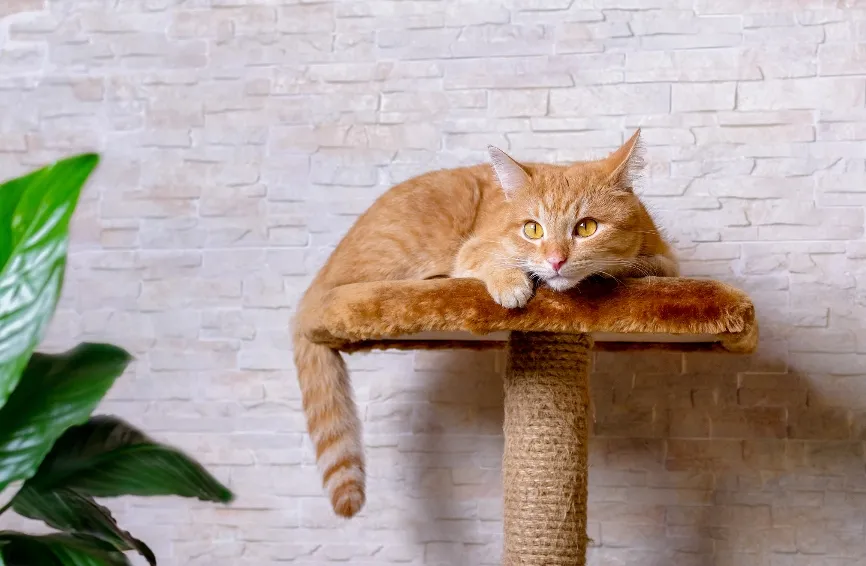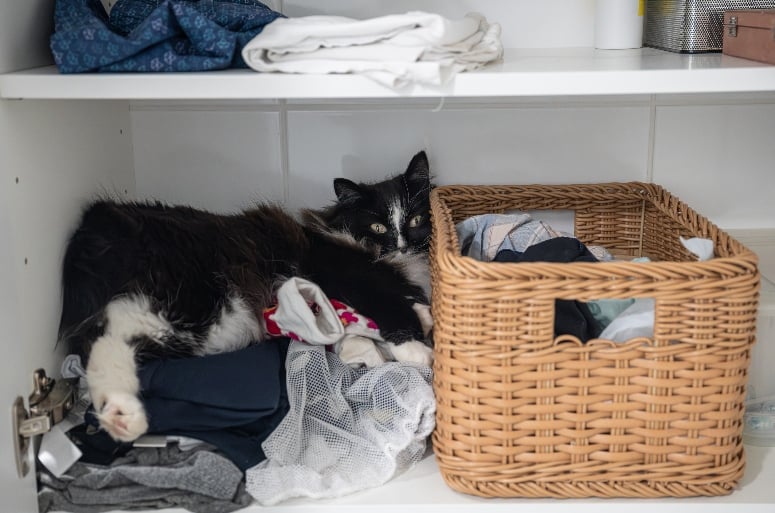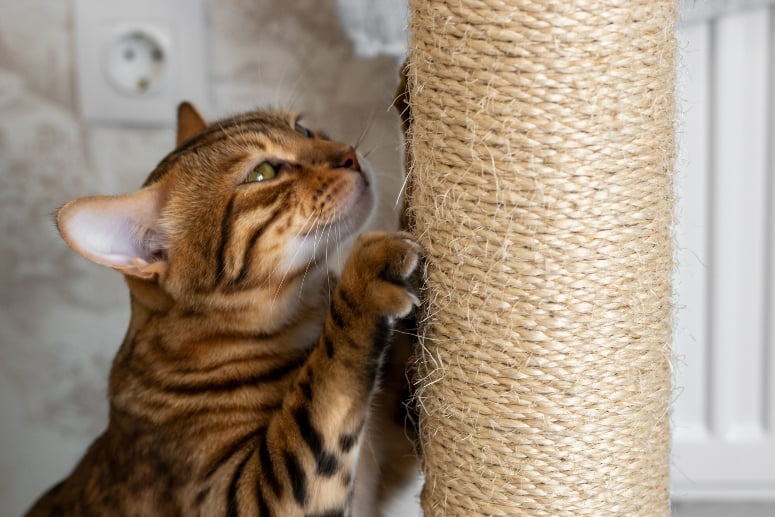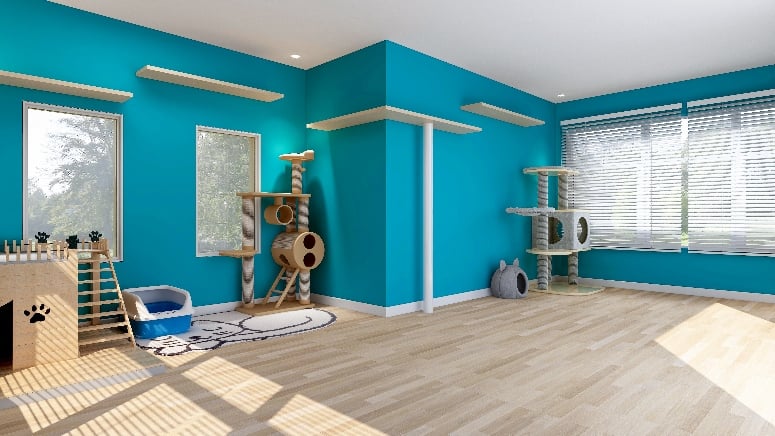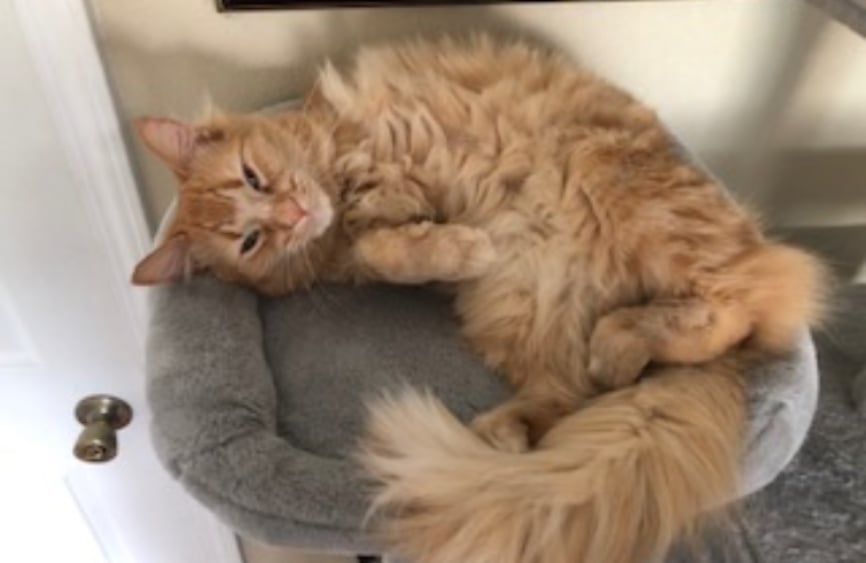Table of Contents
Cat expert Jackson Galaxy defines catification as “the art of creating an enriched home environment acceptable to both you and your cat.” You can design every part of your home you share with your cat to be enriching for your cat while also comfortable for other family members. In his book, Catify to Satisfy he describes creative and inexpensive ways to engage your cat’s hunting, resting and climbing instincts.
When you catify your home, you allow your cat to find confidence and own certain spaces without sacrificing your home style choices. One of the most important ways to do that is by getting to know the vertical spaces where your cat feels most confident.
How a cat sees the world
When a cat walks into a room, it does a three-dimensional assessment of its surroundings in a way that humans don’t. They take in the space from floor to ceiling and assess which places would make good resting spots in your home. We all know that cats love to “perch,” but you might not know that cats start to survey their possible perches as soon as they enter a room. They also make note of spots where they can camouflage themselves to hide, prey/play, or take a quick break from being social.
The first step in catifying your home is finding out where on the vertical axis your cat finds his mojo, Galaxy says. Each cat is individual in the type of place they feel the most confident.
Cats vary in the space they feel safest
Galaxy defines three styles in cats that describe where they prefer to hang out – bush dwellers, tree dwellers and beach dwellers.
Bush Dwellers are cats that like to lie low in the home. They might lie in wait under a coffee table or behind a plant. They are often waiting to hunt or pounce. Bush Dwellers prefer to keep all four paws on the ground.
Tree Dwellers will seek out anywhere up high. These cats feel confident on high perches, being able to see the world from above. They prefer the tops of shelves or dressers, or you might even find them on top of your fridge occasionally, keeping watch over the kitchen.
Beach Dwellers prefer to keep all four feet on the ground, but do not hide like bush dwellers. Rather, they prefer to be out in the open for all to see and notice. Splayed out on a living room floor, their message to all who pass them is, “You can walk around me.”
Figure out which type of cat you have and arrange your furniture and cat-based décor accordingly. Place cat perches, beds and trees based on where your cat feels most confident.
Safety first
First, ensure that your home is a safe environment for your cat. Regularly clean the litter box, remove hazards like hanging cords or small items that could be swallowed, and store toxic substances out of reach. Learn what plants are toxic to cats and remove them or put in an area your cat can’t access.
Incorporate vertical space and areas to climb, jump, play and rest
Cats are natural climbers and enjoy exploring their surroundings from above, especially the tree dwellers mentioned. Adding cat shelves, a scratching post or a cat tree can give your feline friend a new playground. Not only does this satisfy their climbing instincts, but it also allows them to observe their environment from a safe vantage point.
Create a special nook just for your cat. Cats love to have a hideout where they can retreat and feel safe. This could be a soft bed or a cushy blanket in a sunlit spot. Cats love to lounge and soak up the sun, so placing this area by a window is ideal. Consider adding enclosed spaces like cat condos or cardboard boxes, which cats love to hide in. You can also convert an old suitcase or a stylish basket into a cozy retreat for your feline friend.
If you have the space, consider creating a designated playroom for your cat. Fill it with toys, scratching posts, and climbing structures. This can be a fantastic place for your cats to socialize and burn off energy.
Create enrichment opportunities
Boredom can lead to trouble, so providing enough stimulation for your cat is essential. Consider incorporating interactive toys like feather wands, laser pointers, or puzzle feeders.
Cats have a natural instinct to scratch, so providing them with designated scratching posts is essential. You can choose from vertical or horizontal options and place them near their favorite lounging spots or near your furniture. Choose materials that appeal to your cat, such as sisal or cardboard.
You can further release some of their play energy by providing them with toys that mimic the hunt they’re programmed for. Think of toys that look like mice or other small prey. If you’re at work or out of the house for long stretches of time, consider remote-activated toys.
Here are some interactive toys that pet parents rave about:
- Frisco Butterfly Cat Tracks Cat Toy, $11 at Chewy
Reviews: 4.6/5
This interactive triple-tiered tower equips each level with its own colorful rolling ball to provide three stories of stimulating play. - Catstages Kitty Cube Cat Treat Puzzle Toy, $10 at Chewy
Reviews: 4.4/5
This cat puzzle toy stimulates your kitty’s mind and natural foraging instincts. - Shele Tumbler Interactive Cat Toy, $30 at Chewy
Reviews: 4.4/5
Food dispensing design pairs with jerky, snacks or cat food for a tasty reward as your cat plays.
- Agile Moving Cat Ball, $21 at Amazon
Reviews: 4.5/5
An interactive cat ball toy that moves in slow or fast mode that your cat activates by touching. It has a tail and makes a chirping bird sound.
- Motion Activated Automatic Cat Laser Toy, $25 at Amazon.
Reviews: 4.5/5 - A smart sensor detects your pet moving, and the laser toy is automatically activated and works for 15 minutes before turning off. The random pointing of the laser stimulates your cat’s hunting instincts.
You can also make your own toys with just a few household items.
Create a “Cat TV” experience
If you have a television, your sofa probably faces towards it. In the same way, your cat’s “furniture” should face towards his entertainment: the window. In front of the window, add a perch, cat tree, or bed to encourage your cat sit and watch the world all day. These observations stimulate important instincts in cats, like hunting.
If windows are scarce in your house, consider an aquarium (just be sure it has a cat-proof lid!). This will similarly engage your cat.
Utilize multi-functional furniture
Having a catified home doesn’t mean it has to look cluttered or crowded. Look for furniture that serves a dual purpose. Cat trees with built-in scratching posts or storage boxes that double as cat beds can save space while providing your kitty with the essentials. You can also find stylish litter boxes that blend seamlessly with your decor.
Some pet product designers go all out to make cat furniture that is downright stylish and that blends in with your decor. Yanko Design, a website that specializes in exceptionally well-designed products has some beautiful furniture that is customized for pets. For example, they feature a couch with a tunnel for a back rest, a console made of natural materials that cats can crawl into, and a play structure shaped like a city skyline they can explore.
Consider a “Catio”
Cats who spend time outdoors are at risk for accidents, predators, and getting lost. They also kill a lot of birds. If you’d like your cat to enjoy some outdoors time without the risk, a “catio” is a great compromise. By creating an enclosed space on your existing patio, you can offer all the stimulation of the outdoors with the protection of the indoors. Add vertical spaces, wooden scratching objects, and grasses like catnip to create a cozy “outdoor” space for your cat. They’ll also reap the benefits of some fresh air and vitamin D without leaving the safety of your home. Here is a guide on how to create a catio yourself that fits your home.
Conclusion
Catifying your home is all about creating a space that feels special and safe for your feline friend. By incorporating these tips, you can build a cozy, stimulating environment that meets their needs while also looking great in your home.
